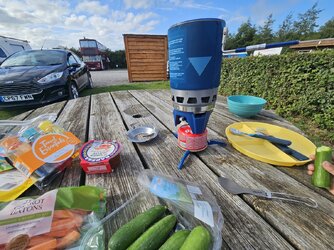By Bikepacking I presume you mean touring with frame mounted soft bags rather than the more traditional rack and panniers. With bikepacking bags, space is at a premium due to there smaller size and awkward shape, which precludes bulkier cooksets like the Trangia.
There seems to be generally two styles of cookset that are popular. First is the meths burner, basically the burner unit from a Trangia, with a much smaller collapsible windshield/pot stand. A light simple unit that will pack up into whichever pot set that you decide to use. The deal breaker for me with such a set up, is the need for a separate leak proof bottle to carry the meths in, I simply don't have anywhere to carry such a thing.
I've gone for the second option of a small gas stove, in my case the MSR Pocket Rocket 2. The stove itself will sit in the palm of my hand, yet is powerful enough to heat water in a few minutes. My complete cookset comprises the stove, two pans, a lid, a fire striker which works in the rain and when wet, a small cloth and a pan handle. Aside from the small bowl in the MSR cookset, I don't carry any other additional bowls or plates, the only thing not pictured here is the small plastic Spork I use to eat with.
View attachment 742736
For brews, I use an Aeropress go, a small French press style of coffee maker. It's really effective and makes some cracking coffee if you brew it for a while before pressing. This is paired with a single walled Titanium mug from Alpkit which can also be used as a pot if I need it.
View attachment 742735
Both of these all nestle down like a Russian doll and all of the stuff in the pictures above, including the gas canister, packs into these two small packages.
View attachment 742737
Cooking wise, I'll often prepare a few things at home to take with me. So a small bag with Olives, sundried tomatoes etc so I can eat foods Like Pasta, Pesto, with Parmesan and pine nuts, olives. Filled Tortellini is also a good one along with Couscous. Homemade vegi chill is another, then all I need to do is cook the rice. The trick is to only carry exactly what you need, so rather than a whole bag of pasta, I'll take just enough for a normal single portion.
Breakfast will often be home made Granola, though Porridge is also good. Fresh Coffee in the Aeropress, if the trip is only a couple of days then a small Nalgene bottle filled with freshly ground beans nestles nicely inside the Aeropress. For longer trips I'll take a small bag of ground coffee beans and use the spoon pictured to get the right amount.
I've written a number of reports of my bike packing adventures in the Travelogue section here on cc and along with that I'll often mention the foods I've eaten. I do like to eat well on trips, so whilst my setup is fairly minimal I don't starve.
The problem I find with some YouTube videos is the glossing over of issues and a reluctance to address or show the problems with bike packing. Many of them also don't carry cooksets and rely on Cafés and restaurants for food, or only eat cold junk food. It is perfectly possible to eat well on a trip it just requires more work and thought when you have limited carrying capacity.
One last thought, I also use a ultralight rucksack that packs down into a miniscule bag. It's great for nipping into supermarkets and picking up food in the last kilometres before your camp. You couldn't use it for long, but it's great for emergency space when needed.

